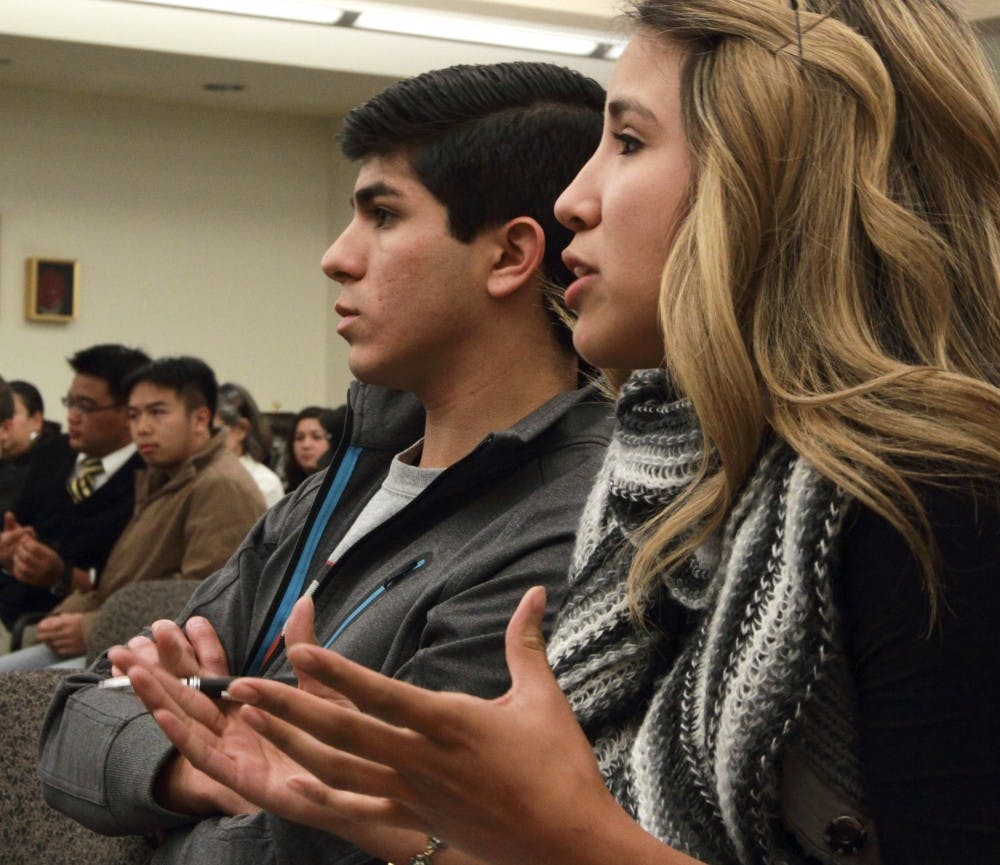news@dailylobo.com
The New Mexico Legislative Lottery Success Scholarship is expected to run out by Fiscal Year 2014, and members of the University said changes should be made to the program to ensure scholarship funding remains available.
At a scholarship town hall on Tuesday, more than 40 University community members sat in on an information session about the Lottery Scholarship. After the session, audience members were able to provide input as to what changes should be made to ensure the scholarship remains available.
Members of the audience addressed New Mexico Legislative Finance Committee Deputy Director Charles Sallee, New Mexico Higher Education Department Cabinet Secretary Jose Garcia, state Rep. Rick Miera (D-Bernalillo) and state Sen. Michael Sanchez (D-Valencia), who were panelists at the meeting. After the end of the town hall, audience members were able to participate in an online survey to share their recommendations for how the scholarship program should change.
Sallee said about 50 percent of New Mexico high school graduates went on to higher education in 1992, before the scholarship was created in 1996. The state ranked 37th in the nation in terms of the number of high school graduates who went to college. He said that by 2006, about 70 percent of New Mexico high school graduates went to college, the sixth highest such rate in the nation.
“That’s a tremendous success story that we should all be proud of in terms of getting more students that are graduating from our high schools to go on to college,” he said. “The challenge now is how to get more students to complete college and to complete on time and the Lottery Scholarship can play a role in that.”
Salle said expenses for the Lottery Scholarship have increased by about 48 percent, or $18.7 million, in the past five years. Of that $18.7 million, $15 million was allocated to research institutions in New Mexico, including UNM. The rest went to other New Mexico institutions.
“That’s pretty much in line with the projections we’ve been making for a number of years,” he said. “What happens when the fund balance is depleted?”
Sallee said that if no changes are made the program, current state regulations for the scholarship could implement across-the-board reductions in the proportion of tuition costs funded by the scholarship for FY 2014. He said that in FY 2015, the fund balance could be in the negative, so there would be further reductions.
“If you are increasing spending on this program of over 50 percent in a short of amount of time, it’s hard to see how revenue could ever keep up with this program’s expenses,” he said. “So we need to look at how to ratchet down, frankly, some of the expenses. We need to do so quickly.”
Sallee said the Legislative Finance Committee recommended this year that the Department of Higher Education analyze how different options to reduce scholarship expenses would affect the scholarship fund. He said some options to reduce scholarship expenses include increasing the minimum credit-hour requirement from 12 credit hours per semester to 15 credit hours per semester, or 30 credit hours per year; differentiating how much money students receive depending on the institution they attend; and not funding remedial courses.
“You can turn this program into a hybrid program where you’d still have a merit component, then also you could have a means testing, so students from lower income or students with targeted income levels would receive aid as a way to still have the program subsidize the tuition cost,” he said. “You could also do that on a sliding scale as one option.”
Get content from The Daily Lobo delivered to your inbox
Executive Vice President for Enrollment Management Terry Babbitt said that in the 2011-2012 academic year, 8,751 students received Lottery Scholarship funding and 68 percent, or 5,945, of those students submitted a FAFSA application. He said that of the students who received the Lottery Scholarship, 35 percent, or 3,078 students, qualified for the Pell Grant.
“3,078 of those were Pell Grant eligible; the neediest in the need population,” he said. “It’s not like a need component isn’t already eligible for about 10 million of the 30 million dollars that UNM has in Lottery Scholarship money, about 10 or 11 million (dollars) goes to need-based students.”
Babbitt said the about $30 million the Lottery Scholarship awards to UNM students accounts for about half of all scholarship money awarded to UNM students.
According to the Higher Education Report, wealthier students at NMSU received the scholarship more frequently than did economically disadvantaged students. More than half of students from families with an income of more than $100,000 per year receive the scholarship, while about 30 percent of students from families with an income between $20,000 and $39,999 receive the Lottery Scholarship, according to the report.
Babbitt said the scholarship program needs to be cut by about 35 percent. He said that, hypothetically, increasing the grade point average requirement for eligibility from a 2.5 GPA to a 3.0 GPA would cut the cost by 26 percent. If the requirement to keep the scholarship was increased to a 3.0 GPA, the cost would be reduced by about 35 percent.
Babbitt said that if the program was awarded only to Pell grant-eligible students, costs would also decrease by about 35 percent.
“It’s 49 million dollars of revenue and 60-something million dollars in expenditure,” he said. “It’s just not going to be sustainable without major changes all the way around.”
Garcia said the department is considering a number of ways to change the scholarship program and that most public input prefers a hybrid of means testing and performance testing for scholarship funding.
“What we’re doing is we’re collecting options of all kinds and we’re going to present those to the governor to see what she thinks,” he said. “I think many people want means testing and performance testing. We just have not made up our minds yet because we’re looking at the fiscal impact of these options.”






